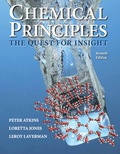
(a)
Interpretation:
The molar solubility of
Concept Introduction:
Solubility product:
The equilibrium constant is defined as solubility product and it denoted by the symbol of
(a)
Answer to Problem 6I.2E
The molar solubility of
Explanation of Solution
The solubility equilibrium of silver iodide, chemical equation is given below.
The equation for solubility product is
Substitute the obtained values in below solubility product equation.
The molar solubility of silver iodide is
Molar solubility = s
Substitute s value in above expression,
Therefore, the
(b)
Interpretation:
The molar solubility of
Concept introduction:
Refer to part (a).
(b)
Answer to Problem 6I.2E
The molar solubility of
Explanation of Solution
The solubility equilibrium of
The equation for solubility product is
Substitute the obtained values in below solubility product equation.
The molar solubility of
Molar solubility = s
Substitute s value in above expression,
Therefore, the
(c)
Interpretation:
The molar solubility of
Concept introduction:
Refer to part (a).
(c)
Answer to Problem 6I.2E
The molar solubility of
Explanation of Solution
The solubility equilibrium of
The equation for solubility product is
Substitute the obtained values in below solubility product equation.
The molar solubility of
Molar solubility = s
Substitute s value in above expression,
Therefore, the
(d)
Interpretation:
The molar solubility of
Concept introduction:
Refer to part (a).
(d)
Answer to Problem 6I.2E
The molar solubility of
Explanation of Solution
The solubility equilibrium of
The equation for solubility product is
Substitute the obtained values in below solubility product equation.
The molar solubility of
Molar solubility = s
Substitute s value in above expression,
Therefore, the
Want to see more full solutions like this?
Chapter 6 Solutions
EBK CHEMICAL PRINCIPLES
- Actually, the carbon in CO2(g) is thermodynamically unstable with respect to the carbon in calcium carbonate(limestone). Verify this by determining the standardGibbs free energy change for the reaction of lime,CaO(s), with CO2(g) to make CaCO3(s).arrow_forwardDescribe a nonchemical system that is not in equilibrium, and explain why equilibrium has not been achieved.arrow_forwardDetermine the equilibrium constant for the reaction Sn+Pb2+Sn2++Pbarrow_forward
- According to the Resource Conservation and Recovery Act (RCRA), waste material is classified as toxic and must be handled as hazardous if the lead concentration exceeds 5 mg/L. By adding chloride ion, the lead ion will precipitate as PbCl2, which can be separated from the liquid portion. Once the lead has been removed, the rest of the waste can be sent to a conventional waste treatment facility. How many grams of sodium chloride must be added to 500 L of a waste solution to reduce the concentration of the Pb2+ ion from 10 to 5 mg/L?arrow_forwardThe equation for a reaction by which a solution of sodium carbonate may be standardized is 2HC7H5O2+Na2CO32NaC7H5O2+H2O+CO2. A student determines that 5.038g of HC7H5O2 uses 51.89mL of sodium carbonate solution in the titration. Find the molarity of the sodium carbonate.arrow_forward5.49. Consider the following equilibrium: What is the effect on the equilibrium of each of the following changes? (You may need to calculate some standard enthalpy or Gibbs energy changes to answer these.) (a) The pressure is increased by decreasing the volume. (b) The temperature is decreased. (c) The pressure is increased by the addition of nitrogen gas, .arrow_forward
- Explain why the hydration process for concrete is exothermic by considering the chemical bonds in the reactants and products.arrow_forwardUse the appropriate tables to calculate H for (a) the reaction between MgC03(s) and a strong acid to give Mg2+(aq), CO2(g), and water. (b) the precipitation of iron(III) hydroxide from the reaction between iron(III) and hydroxide ions.arrow_forward
- Chemistry: Matter and ChangeChemistryISBN:9780078746376Author:Dinah Zike, Laurel Dingrando, Nicholas Hainen, Cheryl WistromPublisher:Glencoe/McGraw-Hill School Pub Co
 World of Chemistry, 3rd editionChemistryISBN:9781133109655Author:Steven S. Zumdahl, Susan L. Zumdahl, Donald J. DeCostePublisher:Brooks / Cole / Cengage Learning
World of Chemistry, 3rd editionChemistryISBN:9781133109655Author:Steven S. Zumdahl, Susan L. Zumdahl, Donald J. DeCostePublisher:Brooks / Cole / Cengage Learning Physical ChemistryChemistryISBN:9781133958437Author:Ball, David W. (david Warren), BAER, TomasPublisher:Wadsworth Cengage Learning,
Physical ChemistryChemistryISBN:9781133958437Author:Ball, David W. (david Warren), BAER, TomasPublisher:Wadsworth Cengage Learning,  Principles of Modern ChemistryChemistryISBN:9781305079113Author:David W. Oxtoby, H. Pat Gillis, Laurie J. ButlerPublisher:Cengage Learning
Principles of Modern ChemistryChemistryISBN:9781305079113Author:David W. Oxtoby, H. Pat Gillis, Laurie J. ButlerPublisher:Cengage Learning Chemistry: Principles and PracticeChemistryISBN:9780534420123Author:Daniel L. Reger, Scott R. Goode, David W. Ball, Edward MercerPublisher:Cengage Learning
Chemistry: Principles and PracticeChemistryISBN:9780534420123Author:Daniel L. Reger, Scott R. Goode, David W. Ball, Edward MercerPublisher:Cengage Learning Introductory Chemistry: An Active Learning Approa...ChemistryISBN:9781305079250Author:Mark S. Cracolice, Ed PetersPublisher:Cengage Learning
Introductory Chemistry: An Active Learning Approa...ChemistryISBN:9781305079250Author:Mark S. Cracolice, Ed PetersPublisher:Cengage Learning





